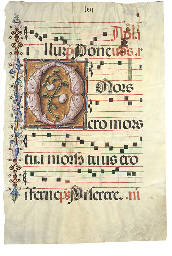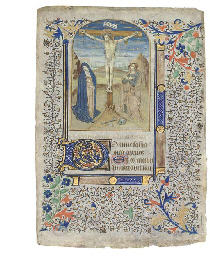The Evangelist John, with his attribute and pointing to a copy of his Gospel, with a single Latin word Iohannis in Insular capitals, on a silver cornerpiece from an Anglo-Saxon bookbinding [England, seventh to ninth century (most probably ninth century)] Silver cornerpiece, formed to fit around one outer corner of a bookbinding, with niello carving in surface showing John standing within a roundel pointing to an open book, with his attribute of an eagle peeping around his right shoulder, IO/HA/NNIS in Phase II Insular capitals over his left shoulder, three animal masks (probably two roaring bears and a snake with bulging eyes) at interior corners, the bears with pouncing to their muzzles, the open eyes of these animals serving as holes for the pins to hold the piece to the book board, 30mm. square A fine example of high-grade Anglo-Saxon metalwork, most probably from a key moment in English history: the Viking invasions and the repelling of those by King Alfred Provenance: 1. From the binding of a de luxe Anglo-Saxon codex, most probably a Gospel Book of the ninth century. An archaeo-metallurgical report by Dr. Brian Gilmour (employing energy dispersive X-ray fluorescence and photomicroscopy of micro-cracking to the surface) indicates that this item is of an early medieval date, with trace impurities of copper and lead probably due to the reuse of impure scrap silver in its production. It may have been originally gilded, having a surprisingly high 8.9% gold reading on its surface (against 0.64% from section analysis). This use of gold, as well as the close stylistic comparisons with other refined examples of Anglo-Saxon metalwork (see below) sets this among the finer products of ninth-century England. The ninth century saw many opportunities for the breaking down of earlier bindings into their component scrap parts, and also for the production of the parent book of this decoration. Viking attack swept across England in the first half of the ninth century, bringing all states there to their knees, with the exception of Wessex. Much metalwork must have been seized by the invaders, and many communities must have been left without essential Christian books. In the last decades of that century, Alfred brought this onslaught to a stop, and turned his attention to a necessary renaissance of Christian knowledge and book production, most famously sending a copy of Gregorys Cura Pastoralis in English translation, to every bishopric in the country with an aestel [perhaps pointer] worth 50 mancuses [the equivalent of a half a pound of gold]. The present piece may have been taken from a codex during the invasions and lost, or been part of a new codex copied to replace one lost during the invasions. 2. From an English collection, and previously in the Don Lee antiquities collection before 1990. Text and art style: The Latin inscription here is in Phase II style Insular capitals, those stemming from the display script developed in a Hiberno-Saxon context c. 700, and used in England from the eighth century to somewhere in the ninth century. In manuscript art they are found most prominently in the Book of Cerne (Mercia, ninth century; Cambridge University Library, MS. Ll.I.10), and in metalwork in the inscription (again for John the Evangelist) on a gold niello plaque of almost the same dimensions and doubtless also from a book binding (now British Museum M&LA 1978, 1-1,1: reproduced in L. Webster and J. Backhouse, The Making of England, 1991, no. 66a, pp. 82-83). In these two cases as well as the present one the capitals are thin and angular with an A whose second stroke extends above the apex of the letter and curves to the left. All that separates them are minor features (here the leaning cross bars of the Ns are higher than those of the others and the lowermost stroke of the S is diagonal rather than sitting on the horizontal line) or paleographical aspects set by the media the scribe was working in (the Book of Cerne has long curling pen
The Evangelist John, with his attribute and pointing to a copy of his Gospel, with a single Latin word Iohannis in Insular capitals, on a silver cornerpiece from an Anglo-Saxon bookbinding [England, seventh to ninth century (most probably ninth century)] Silver cornerpiece, formed to fit around one outer corner of a bookbinding, with niello carving in surface showing John standing within a roundel pointing to an open book, with his attribute of an eagle peeping around his right shoulder, IO/HA/NNIS in Phase II Insular capitals over his left shoulder, three animal masks (probably two roaring bears and a snake with bulging eyes) at interior corners, the bears with pouncing to their muzzles, the open eyes of these animals serving as holes for the pins to hold the piece to the book board, 30mm. square A fine example of high-grade Anglo-Saxon metalwork, most probably from a key moment in English history: the Viking invasions and the repelling of those by King Alfred Provenance: 1. From the binding of a de luxe Anglo-Saxon codex, most probably a Gospel Book of the ninth century. An archaeo-metallurgical report by Dr. Brian Gilmour (employing energy dispersive X-ray fluorescence and photomicroscopy of micro-cracking to the surface) indicates that this item is of an early medieval date, with trace impurities of copper and lead probably due to the reuse of impure scrap silver in its production. It may have been originally gilded, having a surprisingly high 8.9% gold reading on its surface (against 0.64% from section analysis). This use of gold, as well as the close stylistic comparisons with other refined examples of Anglo-Saxon metalwork (see below) sets this among the finer products of ninth-century England. The ninth century saw many opportunities for the breaking down of earlier bindings into their component scrap parts, and also for the production of the parent book of this decoration. Viking attack swept across England in the first half of the ninth century, bringing all states there to their knees, with the exception of Wessex. Much metalwork must have been seized by the invaders, and many communities must have been left without essential Christian books. In the last decades of that century, Alfred brought this onslaught to a stop, and turned his attention to a necessary renaissance of Christian knowledge and book production, most famously sending a copy of Gregorys Cura Pastoralis in English translation, to every bishopric in the country with an aestel [perhaps pointer] worth 50 mancuses [the equivalent of a half a pound of gold]. The present piece may have been taken from a codex during the invasions and lost, or been part of a new codex copied to replace one lost during the invasions. 2. From an English collection, and previously in the Don Lee antiquities collection before 1990. Text and art style: The Latin inscription here is in Phase II style Insular capitals, those stemming from the display script developed in a Hiberno-Saxon context c. 700, and used in England from the eighth century to somewhere in the ninth century. In manuscript art they are found most prominently in the Book of Cerne (Mercia, ninth century; Cambridge University Library, MS. Ll.I.10), and in metalwork in the inscription (again for John the Evangelist) on a gold niello plaque of almost the same dimensions and doubtless also from a book binding (now British Museum M&LA 1978, 1-1,1: reproduced in L. Webster and J. Backhouse, The Making of England, 1991, no. 66a, pp. 82-83). In these two cases as well as the present one the capitals are thin and angular with an A whose second stroke extends above the apex of the letter and curves to the left. All that separates them are minor features (here the leaning cross bars of the Ns are higher than those of the others and the lowermost stroke of the S is diagonal rather than sitting on the horizontal line) or paleographical aspects set by the media the scribe was working in (the Book of Cerne has long curling pen













Testen Sie LotSearch und seine Premium-Features 7 Tage - ohne Kosten!
Lassen Sie sich automatisch über neue Objekte in kommenden Auktionen benachrichtigen.
Suchauftrag anlegen